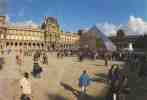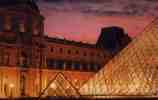![]()
 The Vikings camped on this spot on the Right Bank in their
unsuccessful siege of Paris in 885, and in 1220 King Philippe-
Auguste selected it to plant a square crusaders castle before the
new city wall, as key to the western defenses. Through
subsequent centuries and the attentions of 11 monarchs, the
château-fort was made into one of the worlds biggest palaces,
completed in 1852. The last of the Gothic portions disappeared
only in 1673. From the original square, two galleries extend
westward for 1,640 feet, one along the river, the other along the
rue de Rivoli. Only 19 years after the huge oblong was finally
completed, its western face, the Tuileries Palace (begun 1563),
was destroyed by the insurrection of the Commune, in 1871.
The Vikings camped on this spot on the Right Bank in their
unsuccessful siege of Paris in 885, and in 1220 King Philippe-
Auguste selected it to plant a square crusaders castle before the
new city wall, as key to the western defenses. Through
subsequent centuries and the attentions of 11 monarchs, the
château-fort was made into one of the worlds biggest palaces,
completed in 1852. The last of the Gothic portions disappeared
only in 1673. From the original square, two galleries extend
westward for 1,640 feet, one along the river, the other along the
rue de Rivoli. Only 19 years after the huge oblong was finally
completed, its western face, the Tuileries Palace (begun 1563),
was destroyed by the insurrection of the Commune, in 1871.
 Two of the facades of the original palace square, the Cour
Carrée, have considerable architectural importance and were
strong influences on the development of French styles. Pierre
Lescot began his inner courtyard facade in 1546, adapting the
Renaissance rhythms and orders he had observed in Italy, and
adding purely French decoration to the classical motifs. Claude
Perrault, also distinguished as an anatomist and court physician,
created a masterpiece for the outer east face of the palace in
1673. It, too, employs classic elements--coupled columns and a
pediment--but they are handled with a grace and originality that
makes it perfect for the late reign of the Sun King.
Two of the facades of the original palace square, the Cour
Carrée, have considerable architectural importance and were
strong influences on the development of French styles. Pierre
Lescot began his inner courtyard facade in 1546, adapting the
Renaissance rhythms and orders he had observed in Italy, and
adding purely French decoration to the classical motifs. Claude
Perrault, also distinguished as an anatomist and court physician,
created a masterpiece for the outer east face of the palace in
1673. It, too, employs classic elements--coupled columns and a
pediment--but they are handled with a grace and originality that
makes it perfect for the late reign of the Sun King.
 For so many centuries the seat of French power, the Louvre still
contains some national administrative offices in the rue de Rivoli
gallery, where a separate museum, the Musée des Arts
Décoratifs, is also housed. The gallery is an awkward
19th-century counterfeit of the riverside arm (Galerie du Bord de
l'Eau) built in the last half of the 16th century. The Louvre,
known formally as the Musée du Louvre, occupies the older
gallery, the palace around the Cour Carrée, and, at the far end of
the Tuileries Garden, the galleries of the Orangerie and the
Musée du Jeu de Paume. Among the treasures of the museum,
one of the worlds greatest, are the Victory of Samothrace, the
Venus de Milo, and the Mona Lisa. The enormous collections
contain works from 7BC to the mid-19th century, with a huge
cultural and geographic spread. The Ecole du Louvre, in addition
to its regular university-level curricula, offers free public evening
classes in art history.
For so many centuries the seat of French power, the Louvre still
contains some national administrative offices in the rue de Rivoli
gallery, where a separate museum, the Musée des Arts
Décoratifs, is also housed. The gallery is an awkward
19th-century counterfeit of the riverside arm (Galerie du Bord de
l'Eau) built in the last half of the 16th century. The Louvre,
known formally as the Musée du Louvre, occupies the older
gallery, the palace around the Cour Carrée, and, at the far end of
the Tuileries Garden, the galleries of the Orangerie and the
Musée du Jeu de Paume. Among the treasures of the museum,
one of the worlds greatest, are the Victory of Samothrace, the
Venus de Milo, and the Mona Lisa. The enormous collections
contain works from 7BC to the mid-19th century, with a huge
cultural and geographic spread. The Ecole du Louvre, in addition
to its regular university-level curricula, offers free public evening
classes in art history.
Crossing from the Louvre to the Institut, the Pont des Arts is one of the most charming of all the Parisian bridges. It was the first (1803) to be made of iron, and has always been reserved for pedestrians: it provides an intimate view of riverside Paris and of the Seine itself.